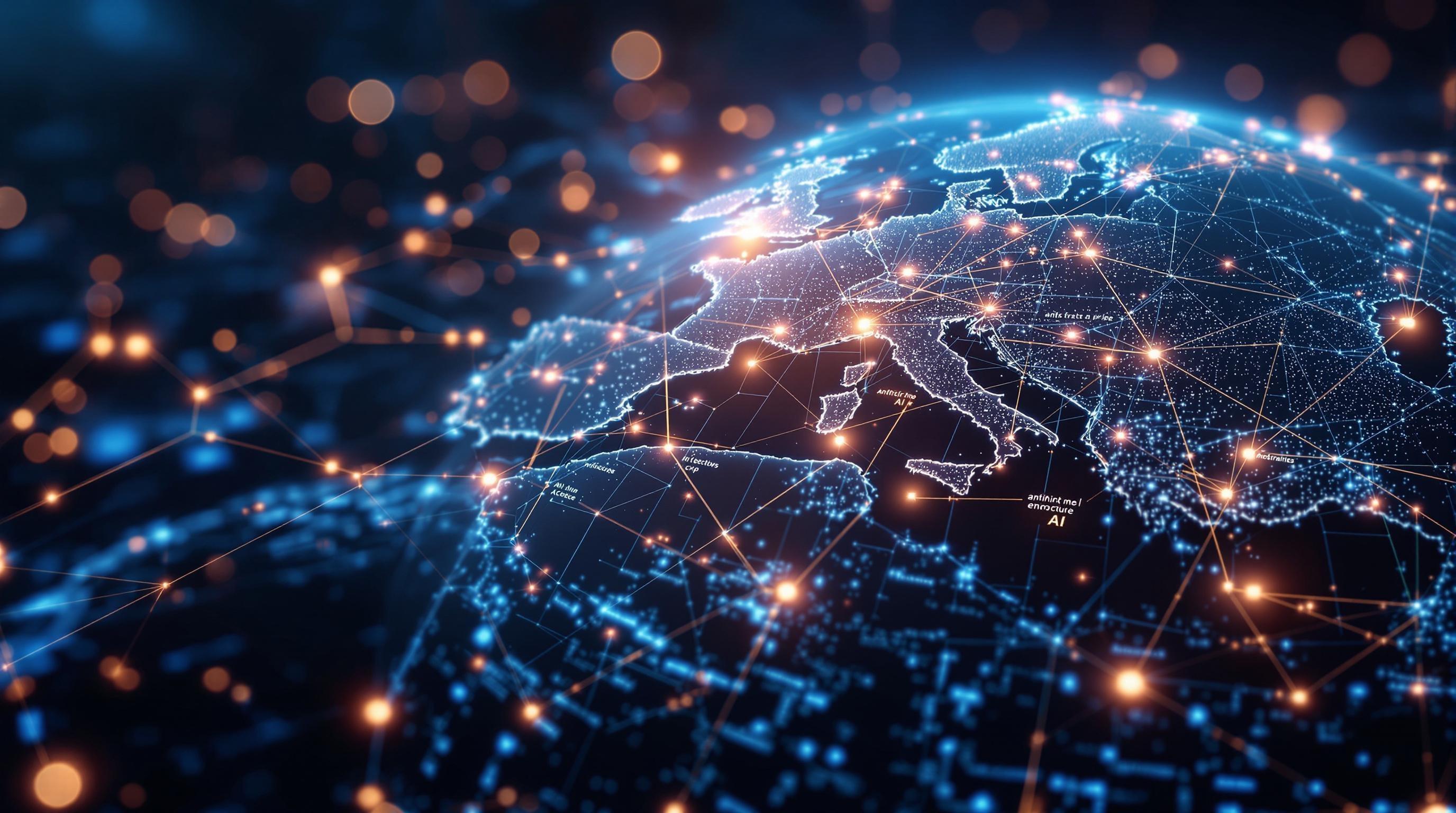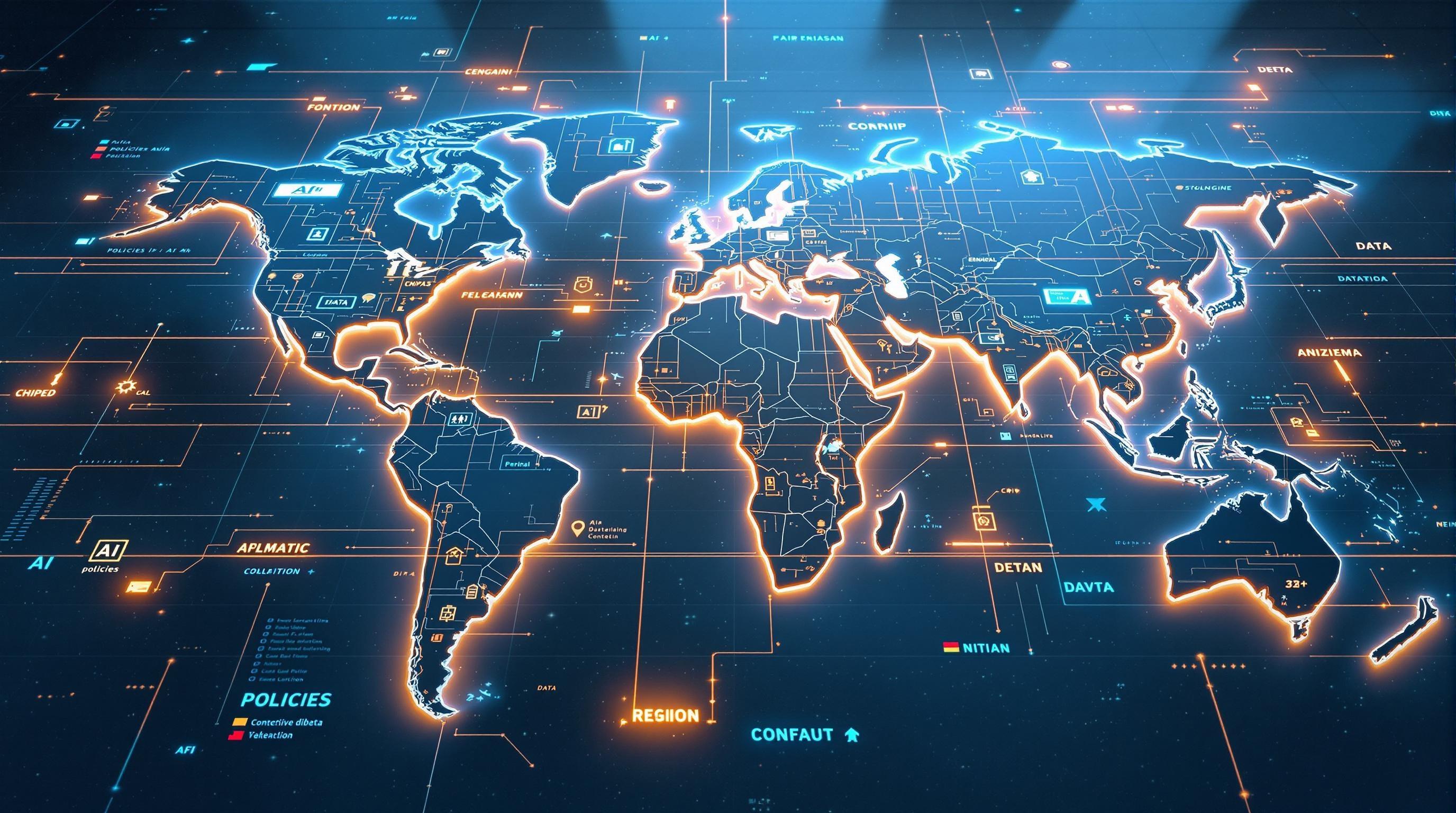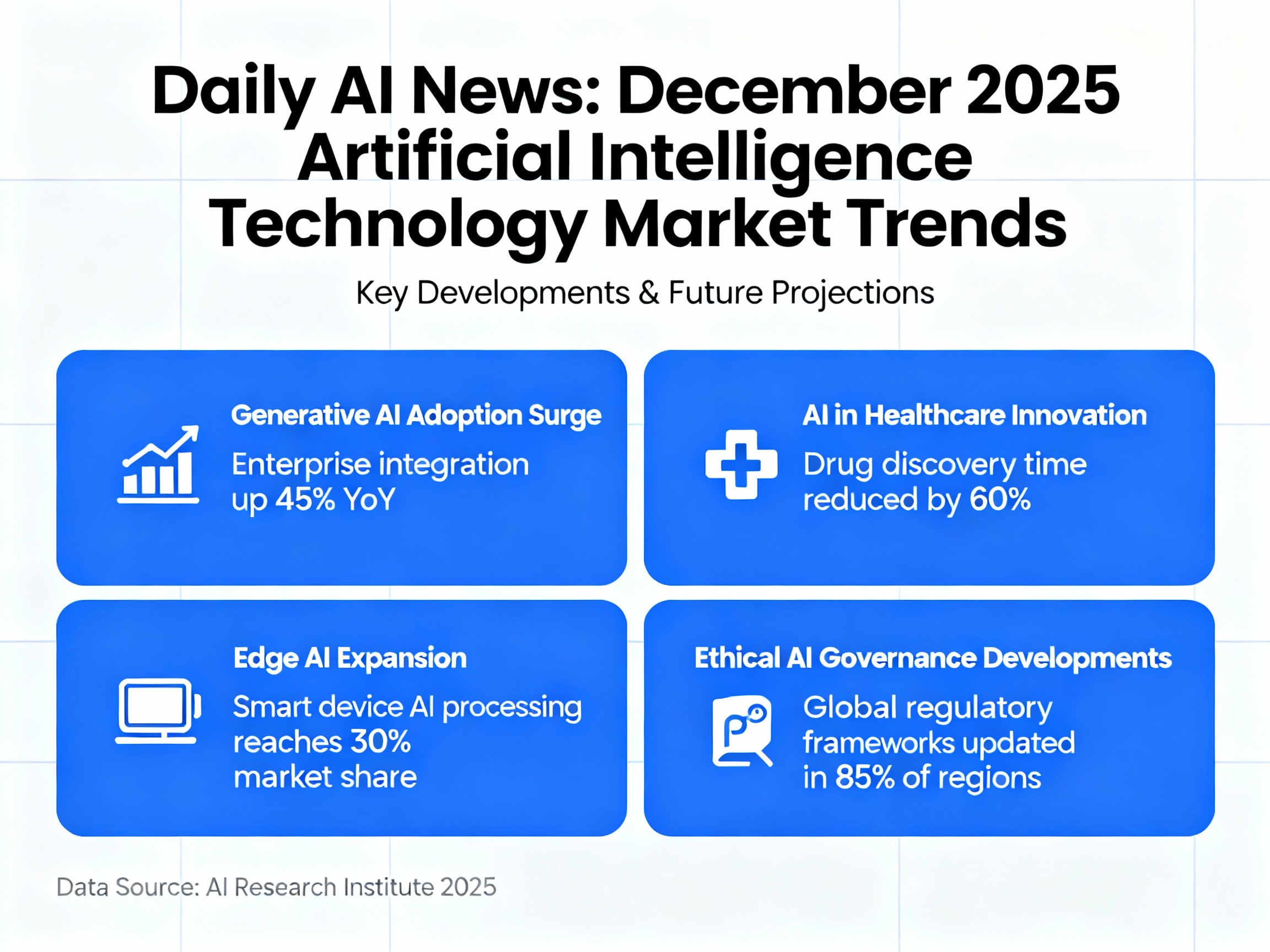AI Trends July 2025: US-China Standoff, Investment Returns, and Search Revolution

The global AI regulatory landscape is diverging as the EU proactively regulates AI with its General-Purpose AI Code, while the US opts for deregulation to foster innovation, creating a compliance nightmare for global AI players. To stay ahead, companies must invest in compliance expertise and adapt their AI systems to meet diverse regulatory requirements, and you can follow the latest AI regulation news at AI News.
US-China AI Standoff: Nvidia Summoned Over Chip Security
The geopolitical chessboard of AI is heating up, with tensions between the US and China reaching a new level in July 2025. This escalating conflict, fueled by technological advancements and security concerns, threatens to reshape the global AI landscape.
Nvidia Summoned Amidst Chip Security Concerns
The latest flashpoint in this ongoing saga involves chip giant Nvidia. China's Cyberspace Administration (CAC) reportedly summoned Nvidia executives to discuss alleged security risks associated with the company's H20 AI chips. The heart of the matter lies in concerns over potential "backdoors" embedded within these chips, raising the specter of data breaches and unauthorized access. Imagine a secret passage built into the very foundation of AI, potentially allowing unseen actors to compromise sensitive information. That's the level of worry these allegations are stirring.

A Controversial Reapproval
Adding fuel to the fire, this development comes just weeks after the US government reapproved the export of Nvidia chips to China, a decision that now faces intense scrutiny. This reapproval was seen as a way to potentially ease tensions and allow for continued economic exchange, but the CAC's actions suggest that China remains deeply wary of the security implications. It's like extending an olive branch, only to have it met with suspicion and skepticism.
Deepening Tech Decoupling
This incident underscores the deepening tech decoupling between the US and China, a trend that has been gaining momentum for years. Both nations are increasingly wary of relying on each other for critical technologies, particularly in strategic sectors like AI. The consequences of this decoupling are far-reaching, potentially fragmenting the global technology ecosystem and hindering innovation. This separation is not just about trade; it's about control, security, and the future of technological leadership. This trend is often covered in AI News.
Looming Export Curbs
The H20 AI chip controversy also raises the specter of fresh export curbs on AI chips. If the US government concludes that these chips pose a genuine security risk, it could reimpose restrictions, further limiting China's access to advanced AI technology. Such a move would undoubtedly escalate tensions and further disrupt global supply chains. It’s a high-stakes game of chess, where each move can have significant repercussions.
Threats to Global AI Supply Chains
These escalating tensions pose a significant threat to global AI supply chains. The AI industry relies on a complex web of suppliers and manufacturers spread across the globe. Any disruption to this network, whether through export controls or geopolitical conflict, could have a ripple effect, impacting everything from AI research and development to the deployment of AI-powered applications. The top AI tools could be affected by the disruption of the AI chips.
The US-China AI technology standoff, the H20 AI chip controversy, and the potential for further AI chip export restrictions paint a complex picture of the challenges and uncertainties facing the global AI landscape. This situation will require careful navigation by policymakers and industry leaders alike to mitigate the risks and ensure the responsible development and deployment of AI technologies. As the AI landscape evolves, resources like the AI glossary will become ever more essential for understanding the key terminologies involved.

AI Investment Pays Off: Tech Giants Report Massive Returns
Did anyone doubt that betting big on AI would pay off? The Q2 2025 earnings reports are in, and the tech giants are proving that strategic AI investment is already yielding massive returns.
Microsoft's Azure Soars
Microsoft is leading the charge, reporting a staggering $76.4 billion in revenue. But the real headline is the growth of Azure, their cloud computing platform, which saw a 39% year-over-year increase. This surge is directly attributable to the integration of AI services, empowering businesses to leverage cutting-edge tools like Azure Machine Learning for predictive analytics, automation, and personalized experiences. Microsoft's intelligent cloud is not just a platform; it's a launchpad for AI-driven innovation.
Azure's growth is a clear indicator that businesses are not just experimenting with AI; they're deploying it at scale.
Key Takeaway: Azure's impressive growth validates Microsoft's AI-first strategy and highlights the demand for cloud-based AI solutions.
Meta's AI Infrastructure Push
Meta is going all-in on the infrastructure required to power the next generation of AI. They've unveiled plans to spend a jaw-dropping $72 billion on AI infrastructure in 2025 alone. This investment encompasses everything from custom-designed AI chips to massive data centers optimized for AI workloads. Meta understands that AI is not just about algorithms; it's about having the raw computing power to train and deploy those algorithms at scale. They are building the foundation for an AI-powered future, with tools like AI Studios to help creators.
Key Investments:
Custom AI chips
AI-optimized data centers
Advanced networking infrastructure
This level of commitment sends a clear signal: Meta believes AI is the key to unlocking new levels of user engagement, personalized experiences, and innovative products across its platforms.
$500 Billion Market Cap Surge
The financial markets are taking notice. The collective market capitalization of these AI-focused tech giants has increased by a staggering $500 billion in the past quarter. This isn't just hype; it's a reflection of the real revenue and future growth potential that investors see in these companies' AI strategies. Investors are rewarding companies that are not just talking about AI, but are actively investing in it and delivering tangible results.
Consider the following table:
Company | Market Cap Increase (Q2 2025) | Key AI Initiatives |
|---|---|---|
Microsoft | $200 Billion | Azure AI services, Copilot integration across products |
Meta | $150 Billion | AI infrastructure investments, AI-powered personalization across Facebook & Instagram |
$100 Billion | Gemini AI model, AI-powered search enhancements | |
Amazon | $50 Billion | AWS AI services, AI-driven automation in e-commerce and logistics |
The Validation of AI Investment
These financial gains are not based on speculation; they are rooted in real revenue generated from AI-powered products and services. Whether it's Azure's AI-driven cloud services, Meta's personalized advertising algorithms, or Google's AI-enhanced search results, AI is directly contributing to the bottom line. This real-world validation is what separates the current AI boom from previous cycles of hype and disappointment.
The key difference in 2025 is that AI is not just a promise; it's a proven driver of revenue and growth.
The CapEx Conundrum
However, some analysts are starting to wonder if we are heading towards a CapEx bubble across the AI sector. The massive investments in infrastructure, talent, and research could lead to overcapacity and diminishing returns in the long run. It's a valid concern, and companies need to carefully manage their AI spending to ensure they are not overinvesting in areas that will not generate sufficient returns.
Potential Risks:
Overcapacity in AI infrastructure
Diminishing returns on AI investments
Increased competition and price wars
Despite the potential risks, the overall picture is clear: AI investment is paying off in 2025. Tech giants are reporting massive returns, and the financial markets are rewarding companies that are leading the charge. This trend is likely to continue as AI becomes even more deeply integrated into every aspect of our lives.
The impressive financial results are setting the stage for even more intense competition and innovation in the AI News space.

OpenAI Expands Global Footprint: Stargate Norway and AI-Powered Learning
The race to dominate the AI landscape is heating up, with major players making strategic moves on multiple fronts. One notable development is OpenAI's continued global expansion.
OpenAI Launches "Stargate Norway"
OpenAI is making significant strides in diversifying its infrastructure with the launch of "Stargate Norway," a new data center project in collaboration with NScale and Aker. This initiative represents a strategic move to reduce dependency on U.S.-based resources while tapping into Norway's robust infrastructure and renewable energy sources. Think of it as OpenAI planting a flag in new territory, ensuring its operations are resilient and globally distributed. This matters because, like any critical infrastructure, spreading out the data centers reduces the risk of single points of failure and strengthens overall reliability. It also allows OpenAI to better serve its international user base with lower latency and improved performance.
By establishing a presence in Norway, OpenAI gains access to a stable, sustainable, and technologically advanced environment, setting a precedent for future global expansions.
ChatGPT's New "Study Mode"
Beyond infrastructure, OpenAI is also enhancing the functionality of its flagship product, ChatGPT. The introduction of a new "study mode" signifies a shift towards leveraging AI for personalized education. This feature aims to provide users with step-by-step learning experiences, transforming ChatGPT from a mere chatbot into an interactive educational tool. This is a game-changer because it moves AI beyond simple automation and into the realm of active learning assistance. Imagine having a personalized tutor available 24/7, guiding you through complex subjects at your own pace. That's the potential of ChatGPT's study mode.
AI in Personalized Education
AI's role in education is rapidly evolving. It's not just about automating grading or providing quick answers; it's about creating customized learning paths tailored to individual needs. The new "study mode" in ChatGPT exemplifies this trend, offering features like:
Interactive Q&A: Engaging students with questions and providing immediate feedback.
Step-by-Step Guidance: Breaking down complex topics into manageable steps.
Personalized Learning Paths: Adapting the learning experience based on the student's progress and understanding.
This approach to personalized education has the potential to revolutionize how we learn, making education more accessible, engaging, and effective for everyone. Tools like Knowt also embrace AI to help you create flashcards, notes, and quizzes from any content.
OpenAI's Diversified Approach
OpenAI's recent moves highlight a dual strategy: strengthening its global infrastructure and enhancing its AI-powered educational tools. By diversifying its data center locations and launching innovative features like ChatGPT's study mode, OpenAI is positioning itself as a leader in the evolving AI landscape. This two-pronged approach is crucial for long-term success, ensuring both the reliability of its services and the relevance of its AI-powered solutions in an increasingly competitive market. As AI continues to permeate various aspects of our lives, these strategic initiatives will play a pivotal role in shaping the future of education and technology.
Google Revolutionizes Search with AI: A Paradigm Shift for Online Publishing
Imagine a world where search results aren't just a list of links, but a conversation with an AI that understands your needs and provides direct, insightful answers. That future is rapidly approaching, and Google is leading the charge with a radical overhaul of its search engine.
Google's AI Search Revolution in the UK
Google has begun replacing its traditional "blue links" with conversational AI answers for users in the U.K., signaling a monumental shift in how we access information online. This isn't just a minor tweak; it's a complete reimagining of the search experience. Instead of sifting through pages of websites, users are presented with AI-generated summaries and answers directly within the search interface. This approach offers unparalleled convenience and speed, especially for complex queries that would typically require extensive research.
But the changes don't stop there. The new Google search also includes:
File uploads: Allowing users to upload documents for analysis and summarization, making research even more efficient.
Planning documents: AI can assist in creating outlines, schedules, and to-do lists based on search queries.
Live video assistance: Imagine getting real-time help from an AI during a DIY project, guiding you through each step with visual aids and explanations.
These additions transform search from a passive activity into an interactive and personalized experience, effectively turning Google into an AI-powered assistant.
A Paradigm Shift in Online Publishing
The move towards AI-powered search results represents a true paradigm shift. For decades, the internet has been largely organized around a model where websites compete for visibility in search engine results pages (SERPs). This competition has fueled the growth of search engine optimization (SEO) and content marketing, as businesses strive to rank higher and attract more traffic. With Google now offering direct answers, the need to visit individual websites may diminish significantly. This shift has profound implications for online publishing and ad-driven business models.
Potential Traffic Reduction and Its Consequences
Experts predict that this could lead to a potential 50% reduction in website traffic for many online publishers.
This dramatic decrease would undoubtedly put immense pressure on businesses that rely on organic search traffic for revenue. News organizations, blogs, e-commerce sites, and countless other online ventures could face significant challenges in maintaining their current business models. The ripple effects would be felt across the entire digital ecosystem, forcing companies to adapt or risk becoming obsolete. This also affects various AI tools. To stay ahead, content creators can harness the power of AI writing tools to make search-optimized content.
Upending Online Publishing and Ad-Driven Models
The core of the issue is that Google's AI-powered search effectively cuts out the middleman. Instead of directing users to websites that contain the desired information, Google provides the information directly. This means that websites lose the opportunity to display ads, generate leads, or build brand awareness with those users. The traditional ad-driven business model, which has sustained much of the internet for years, is now under threat. Online publishers must explore alternative revenue streams, such as subscriptions, premium content, or direct partnerships, to survive in this new landscape. AI tools such as HubSpot can help businesses adapt their strategies for a changing landscape.
Google's revolutionary changes to search are poised to reshape the internet as we know it. While users may enjoy the convenience and speed of AI-powered answers, the implications for online publishers and ad-driven business models are far-reaching and potentially devastating. The future of online content creation and distribution is now uncertain, requiring innovation and adaptability to thrive in the age of AI.

The Rise of AI Agents: Transforming Business Operations and Workforce Strategies
Imagine a world where digital assistants don't just answer questions, but proactively manage your tasks, learn your preferences, and even anticipate your needs. That future is rapidly unfolding, driven by the rise of AI agents. These sophisticated systems are poised to revolutionize business operations and reshape workforce strategies in ways we're only beginning to understand.
AI Agents: From Pilot Programs to Core Operations
The adoption of AI agents is no longer a futuristic fantasy; it's a current reality. A striking statistic reveals that 65% of enterprises are now piloting autonomous AI agents, signaling a significant shift in how businesses approach automation and workflow management. These pilot programs aren't just theoretical exercises; they represent concrete efforts to integrate AI agents into core operational processes.
Think of it this way: for years, companies have relied on software to automate specific, repetitive tasks. Now, AI agents are taking automation to the next level by handling complex, multi-step tasks that previously required human intervention. This evolution marks a fundamental change in how we perceive and utilize AI in the workplace.
Examples Leading the Charge
Several key projects highlight the capabilities and potential of AI agents. Two notable examples include ChatGPT Agent, OpenAI's foray into autonomous AI, and Google's Project Mariner. The ChatGPT Agent represents a significant leap, designed to execute tasks with minimal human oversight, learning and adapting as it goes. Google's Project Mariner showcases the tech giant's ambition to create AI systems capable of managing intricate workflows, optimizing resource allocation, and making data-driven decisions.
These aren't isolated initiatives. Other companies are actively developing and deploying AI agents tailored to specific industry needs, from customer service to supply chain management. The race to build more sophisticated and capable AI agents is well underway, promising a wave of innovation in the coming years.
The Power of Proactive Automation
One of the most significant shifts is the move from passive AI tools to proactive digital workers. In the past, AI primarily served as a tool to augment human capabilities, providing insights and automating simple tasks. Now, AI agents are becoming active participants in workflows, capable of initiating actions, coordinating tasks, and making decisions independently.
Imagine an AI agent that can not only answer customer inquiries but also proactively identify potential issues, resolve conflicts, and personalize customer experiences – all without human intervention. This level of autonomy represents a paradigm shift in how businesses interact with their customers and manage their operations.
AI agents are now capable of handling intricate tasks that involve multiple steps and require a degree of reasoning. For example, an AI agent could be tasked with booking travel arrangements for an employee, including flights, hotels, and transportation, all while adhering to specific budgetary constraints and preferences. Or, an agent could autonomously work to translate images to text using a tool like ImageToText.info to help businesses save time and resources.
Another compelling example is AI-powered coding assistants. These agents can analyze code, identify errors, suggest improvements, and even generate new code snippets, freeing up developers to focus on more complex and creative tasks. Tools like GitHub Copilot are already making significant strides in this area.
New Challenges, New Strategies
With the rise of AI agents comes a pressing need for new oversight, accountability, and workforce strategies. As AI agents take on more responsibilities, businesses must develop robust mechanisms to monitor their performance, ensure compliance, and address ethical concerns. This includes implementing clear guidelines for AI decision-making, establishing accountability frameworks, and proactively mitigating potential biases.
Moreover, the integration of AI agents into the workforce requires a fundamental rethinking of job roles and skill sets. While AI agents may automate certain tasks, they also create new opportunities for humans to focus on higher-level activities, such as strategic planning, creative problem-solving, and relationship building. Businesses must invest in training and development programs to equip their employees with the skills needed to thrive in an AI-driven world.
The transformation is underway. As AI agents continue to evolve, they will undoubtedly play an increasingly prominent role in shaping the future of work and business operations. Navigating this shift successfully will require a proactive, strategic approach that prioritizes innovation, ethical considerations, and workforce empowerment. But with appropriate oversight, the potential upside is enormous, allowing organizations to achieve new levels of efficiency, productivity, and customer satisfaction. This transition necessitates a closer look at AI's growing influence on search methodologies.
Global AI Regulation: Divergent Paths in the US and EU Create Compliance Challenges
The race to regulate AI is creating a complex global landscape, with the EU and the US taking distinctly different paths, creating significant compliance challenges for global AI players.
EU's Proactive AI Regulation
The European Union is moving full steam ahead with its comprehensive AI regulation. They are set to publish their General-Purpose AI Code ahead of the August 1st enforcement date. This code aims to establish a clear framework for the development and deployment of AI technologies within the EU, focusing on risk management, transparency, and accountability. Think of it as a detailed instruction manual, ensuring AI operates safely and ethically within the EU's borders.
The EU's approach is proactive, seeking to mitigate potential risks before they materialize, establishing a standard for responsible AI development globally.
This framework means that companies offering AI tools within the EU, like DeepL, known for its advanced AI-powered translation services, must adhere to these regulations. This could involve substantial investments in compliance measures, rigorous testing protocols, and ongoing monitoring to ensure adherence to the evolving regulatory landscape.
US Deregulation and Tech Supremacy
In stark contrast, the United States is doubling down on deregulation and tech supremacy in the AI domain. The U.S. AI Action Plan emphasizes minimal intervention, aiming to foster innovation and maintain a competitive edge in the global AI race. The philosophy is that excessive regulation could stifle growth and hinder the development of groundbreaking AI technologies. It's like opening the floodgates to innovation, hoping that the rising tide lifts all boats – and keeps the U.S. at the forefront.
This approach reflects a belief that American ingenuity and market forces will guide AI development in a responsible and beneficial direction.
For companies such as Salesforce Platform, which integrates AI to provide advanced data analysis and automation for businesses, this means a more flexible environment for experimentation and deployment, but potentially less clarity on ethical boundaries and societal safeguards.
Divergent Approaches: A Compliance Conundrum
The contrasting regulatory philosophies of the EU and the U.S. are creating a fractured compliance landscape. The EU's stringent regulations and the U.S.'s deregulatory approach mean that global AI players must navigate a complex web of conflicting rules. Companies face the daunting task of tailoring their AI systems to meet different standards in different regions, potentially increasing costs and complexity.
Consider the challenge faced by companies developing AI-powered marketing tools, which are described in detail in AI News. These tools might need to be designed with specific data privacy safeguards to comply with EU regulations while simultaneously leveraging data more freely in the US market to maximize effectiveness.
Navigating the Global Maze
For global AI players, the reality is navigating conflicting rules while trying to innovate and compete. The cost of compliance could become a significant barrier to entry, particularly for smaller companies and startups that lack the resources to manage the regulatory burden.
Here's a breakdown of the key challenges:
Costly compliance: Adapting AI systems to meet diverse regulatory requirements. This creates a barrier to entry, particularly for smaller players.
Legal uncertainty: Conflicting legal interpretations and enforcement priorities across jurisdictions.
Strategic trade-offs: Balancing innovation with regulatory compliance when entering new markets.
Navigating these challenges will require careful planning, investment in compliance expertise, and a deep understanding of the evolving regulatory landscape. As explored in the AI News section, staying informed and adaptable will be the keys to success in this complex global environment.
Ultimately, the divergent paths of AI regulation in the EU and the US underscore the need for international cooperation and harmonization. Without a common framework, the risk of a fragmented AI ecosystem looms, hindering the potential benefits of this transformative technology.
🎧 Listen to the Podcast
Hear us discuss this topic in more detail on our latest podcast episode: https://creators.spotify.com/pod/profile/bestaitools/episodes/International-AI-Press-Digest--July-31--2025---Global-AI-Crossroads-Chips--Cloud--Agents---Whats-Next-e3691bu
Keywords: AI, Artificial Intelligence, AI Technology, AI Investment, AI Agents, AI Regulation, China AI, US AI, OpenAI, Google AI, Microsoft AI, AI infrastructure spending, AI in education, AI and search, Autonomous AI agents
Hashtags: #AI #ArtificialIntelligence #TechNews #FutureofAI #AITrends
For more AI insights and tool reviews, visit our website https://best-ai-tools.org, and follow us on our social media channels!
Website: https://best-ai-tools.org
X (Twitter): https://x.com/bitautor36935
Instagram: https://www.instagram.com/bestaitoolsorg
Telegram: https://t.me/BestAIToolsCommunity
Medium: https://medium.com/@bitautor.de
Spotify: https://creators.spotify.com/pod/profile/bestaitools
Facebook: https://www.facebook.com/profile.php?id=61577063078524
YouTube: https://www.youtube.com/@BitAutor
Recommended AI tools
Thomson Reuters
Data Analytics
Clarifying the Complex
MediSphere
Productivity & Collaboration
Intelligent Healthcare Management for Doctors & Staff
Dropbox Sign
Productivity & Collaboration
Send, sign, and manage agreements instantly—80% faster than paper.
hCaptcha
Productivity & Collaboration
Stop bots and human abuse.
Copyleaks
Writing & Translation
AI Content & Text Authenticity Detection
Apify
Data Analytics
Automate Anything


